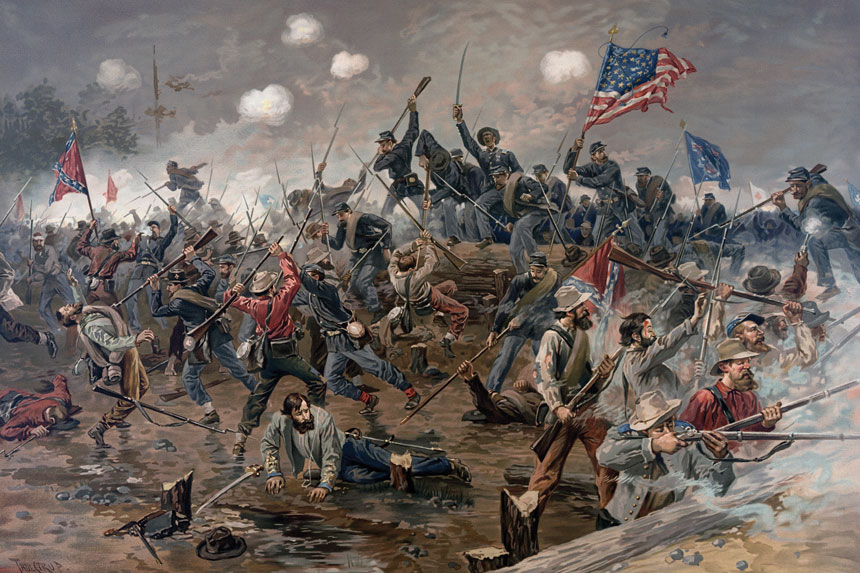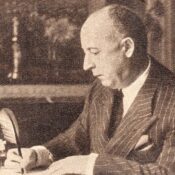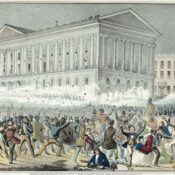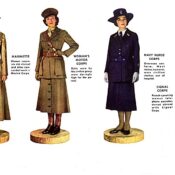Walking through silent, snowy woods, I try to imagine clouds of rifle smoke and the wail of wounded soldiers. This is the contradiction of Civil War battlefields. Time transforms a den of death into a swath of tranquility. No frenzied troops struggle through dense thickets. No Confederates shriek the Rebel Yell. There’s only me on the trail beneath a bright blue sky; only a series of battlefield markers, and gray, leafless trees standing naked in the January cold.
On May 5 and 6, 1864, in the woods and fields where I’m walking, Union and Confederate forces suffered nearly 29,800 casualties combined. The Battle of the Wilderness, about 15 miles from Interstate 95, west of Fredericksburg, Virginia, marked the first titanic clash between Robert E. Lee and Ulysses S. Grant, part of Grant’s Overland Campaign to destroy Lee’s army and end the war. The battle was a Confederate victory, but Grant, who had assumed command of all U.S. armies, had vowed to Abraham Lincoln there would be no turning back. Previous spooked commanders had retreated after losses to the mythic Lee. Cynical Union troops once again expected a “great skedaddle,” but the bulldog Grant turned not north, but south. The men sang and cheered as they marched, though some of the war’s worst bloodshed was still to come.
Most Americans probably aren’t familiar with the Wilderness, even though it had the fourth-highest casualty numbers of any battle in the war. Some Americans aren’t even sure who won the war. In a June 2023 YouGov survey, 30 percent of respondents didn’t know that the North was the victor.
The Civil War can seem like ancient history, and yet it has never left us, particularly in Southern states like my native Virginia. As I drive along the Wilderness battlefield, I take roads used by troops in 1864. A mile or so away, I pass a housing development called The Estates of Lee-Jackson. Eventually, on wooded, twisty, two-lane roads, I spy a rebel flag.
With all due respect to 1968, we live in the most divided time in U.S. history since the Civil War. On January 6, 2021, when a rioter carried the Confederate flag into the U.S. Capitol, the two eras briefly, symbolically merged. “The Confederate flag made it deeper into Washington on January 6, 2021, than it did during the Civil War,” William Blair, professor emeritus of history at Penn State, told The New York Times.
The insurrection sparked still-ongoing debates on the inevitability of a second civil war. “Is Civil War Looming, or Should We Calm Down?” blared a headline from a New York Times op-ed in 2022. The Times has run additional pieces on the subject, as have The Washington Post, National Review, The Atlantic, and The American Conservative.
Two in five Americans believe civil war is “at least somewhat likely” in the next decade, according to a survey by YouGov and The Economist. In an October 2023 poll from the Public Religion Research Institute and the Brookings Institution, 33 percent of Republicans, 22 percent of independents, and 13 percent of Democrats agreed with the statement that “true American patriots may have to resort to violence in order to save our country.”
That’s why I’m road-tripping the route of Lee and Grant’s first three major battles from the spring of 1864: To remember the Civil War’s horrific costs, and the peril of ignoring, as Lincoln said, “the better angels of our nature.”
I’m a Civil War geek. Where I grew up in Fairfax, Virginia, about 20 miles southwest of D.C., shadows of the war were ever-present. The Fairfax Courthouse, roughly 10 minutes from our house, was occupied by both Union and Confederate troops during the war. We would drive on Lee Highway and Jefferson Davis Highway. Lee High School was nearby, as was J.E.B. Stuart High School. My dad worked in the Mosby Building, named after Confederate raider John Mosby. Roughly a mile from our house, at the St. Mary’s Church, Clara Barton treated the wounded from the Second Battle of Manassas in 1862.
Manassas National Battlefield (Northerners called it Bull Run) was also close, about 25 minutes away. The initial Manassas battle, fought in 1861, was the first major clash of the war, at a time when both sides assumed the conflict would be brief. As a kid, I was amazed by stories of merry Washingtonians taking carriages to watch the battle, as if seeing a Broadway show. Even then I thought, who packs a picnic lunch to watch men die?
Between childhood trips to Bull Run and the blue-gray osmosis of living in Virginia, my interest in the war grew (despite my Old Dominion roots, Abraham Lincoln was my earliest historical hero). As an adult, I sought out battlefields. I’ve visited the war’s beginning at Fort Sumter, a short boat ride from Charleston, South Carolina, and the beginning of its end at Appomattox Court House in Virginia. I’ve explored major battlefields in my home state, such as Chancellorsville, site of Lee’s greatest victory (when he split his outmanned army in two, defying military convention), and little-known clashes such as Cedar Mountain, near the town of Orange.
Walking the battlefields is eye-opening. At Gettysburg, I was amazed to see the mile-long field of Pickett’s charge; to see the wide-open ground where Confederates moved, suicidally, toward Union soldiers positioned behind stone walls. When the men in blue opened fire, “a moan went up from the field,” an Ohio soldier remembered. The Rebels suffered over 6,500 casualties in less than an hour.
These moments of fury and slaughter exist at numerous battlefields. At Shiloh, in Tennessee, about 110 miles east of Memphis, there’s a 600-yard stretch called the Hornet’s Nest, the site of fierce combat during the two-day battle. It earned its name from Confederates who said that Union bullets sounded like swarms of angry hornets. At Maryland’s Antietam battlefield, the Sunken Road, later christened the Bloody Lane, was so deeply covered with dead rebels that you could walk on them without ever touching the earth.
The Confederates “were lying in rows like the ties of a railroad, in heaps, like cord-wood mingled with the splintered and shattered fence rails,” a Northern war correspondent wrote.
The casualties at Antietam — 3,650 dead, 17,000 wounded — were twice the number suffered by Allied forces on D-Day in 1944. And yet on the list of Civil War battles with the highest casualties, Antietam doesn’t make the top five.

Walking at the Spotsylvania Court House battlefield, I expect to see ghosts. I do this at every battlefield — even though I’ve never seen a ghost — but here, at the second stop of my Lee-Grant drive (about 20 minutes south of the Wilderness), the conditions seem right. I’m alone, except for four deer, who stop their grassy meal to stare cautiously. It’s quiet. The sun is dropping near the horizon: The light is an orangey, yellowish glow.
Young men died here. Thirty thousand were killed or wounded in fighting that raged for two weeks in May 1864. The pain, the carnage, the fear: That’s why I brace myself for a sudden phantom Union man or a Rebel specter in tattered clothes.
The battlefield is best known for the Bloody Angle: A small bend in the trenches that saw “the most violent sustained combat in American history,” a marker says. For 22 manic hours on May 12, men fought in close quarters in the rain — “A seething, bubbling, roaring hell of hate and murder,” as a private from Maine described it — engaging in hand-to-hand combat with weapons ranging from bayonets and rifle butts to hatchets and fists.
“Blood flowed as copiously as the rain, turning trench floors into a slimy ooze where dead and wounded were trampled down by men fighting for their lives,” historian James M. McPherson wrote in his Pulitzer Prize-winning book Battle Cry of Freedom. “Every soldier,” the Maine private said, “was a fiend.” The gunfire was so intense that a nearly two-foot-wide tree was cut down by minié balls (the battered stump resides at the Smithsonian Institution).
The massive death totals in the Civil War — a result of improved technologies and outdated tactics — are almost incomprehensible for us now. In Iraq and Afghanistan, roughly 6,600 American military personnel died. In four years of civil war, 620,000 died — more than World War I and World II combined. Some experts put the total at 700,000. Another 476,000 were wounded.
At Spotsylvania and the Wilderness, you see earthworks, which in their own way are a type of earthen ghost. Today they are long “modest mounds,” as a marker puts it, but during the battle they were four feet high — stacks of logs covered with mud and dirt — with a two-foot-deep trench. Soldiers would fire their rifles through a small gap under the top log.
I leave the Bloody Angle’s earthworks and pass a gray monument to Ohio’s dead, then walk toward the site of a one-time farmhouse. All that remains are the squat foundations of two wide chimneys, and as I study them, I hear a sound. I turn, quickly, bracing myself for my long-awaited ghost, but it’s the click click click of a squirrel scurrying down a tree and leaping into dry leaves before quickly disappearing. Like the war, he is gone, but still here.
After wandering woodsy trails at the Cold Harbor battlefield — and passing a small creek that had turned red with blood — I walk a few hundred yards along a two-lane road to a military cemetery. Union forces failed to break the Confederate lines at Spotsylvania, so Grant continued marching south, and the two armies slugged their way here, to the crossroads of Cold Harbor, about six miles northeast of Richmond, in a battle that dragged from May 31 to June 12, 1864.
Red brick walls surround the perfectly square cemetery and its uniform white tombstones. Around 2,100 veterans are buried here, most from the summer battles of 1864, but as I walk the grass I see stones for men who fought in World War I, World War II, and even the Korean War. At the far end of the cemetery, a five-foot-high marble sarcophagus marks the remains of 889 unknown Union soldiers gathered from four nearby battlefields. The men are buried together in two large mounds.
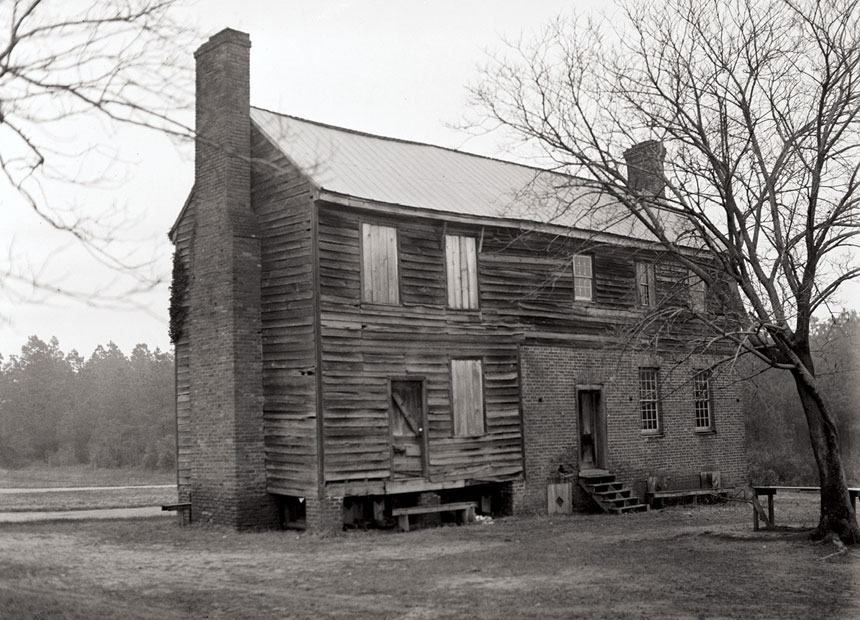
Across the street is the two-story Garthright House. A marker tells me the home was owned by Miles Garthright, a Confederate cavalry officer. Union surgeons used the home as a field hospital (talk about potential for ghosts), and a trembling Mrs. Garthright took refuge in the basement as “blood dripped through the cracks in the floor and into the cellar.” At least 97 soldiers died from their wounds and were temporarily buried in the front yard.
I can’t tell if the Garthright House is a private residence. I see a red car and a sign saying the home is not open to the public. A few other homes face the battlefield and its gravel parking lot and tiny visitors center. I saw this at the Wilderness as well: Houses lined the edge of the woods and were visible from the trails. At each of my three stops, I saw few people — it’s winter, to be fair — but all were clearly locals, most of them walking dogs.
For the people who live here, battlefields are parks. And that’s okay, I suppose. We should respect history, and learn from it, and we should honor those who fought not just for freedom, but for … normalcy. The normalcy of walking our dogs.
After Cold Harbor, Grant’s army began a nine-month siege of Lee at Petersburg, about 25 miles south of Richmond. In April 1865, Lee surrendered. But the restoration of the United States, of a unified nation, was not preordained. It would require Lincoln’s insistence on generous terms for surrendering rebel armies. It would require generals like Lee, who resisted calls for guerrilla warfare and urged his soldiers to be good citizens. It would take good fortune for America to become whole — though African Americans, of course, were denied Lincoln’s promise of a “new birth of freedom.”
The country, however, has endured, however shaky it may feel today. I’m reminded of Lincoln’s first inaugural address: “We are not enemies, but friends,” he said. “Though passion may have strained it must not break our bonds of affection.”
At Spotsylvania, when I returned to the small parking lot near the Bloody Angle, I passed a man on his late-evening walk. He appeared to be in his late 60s, gray hair, gray goatee, a soda cup in his hand. He smiled at me.
“It’s so cold out I think I’ll stay here on the road where it’s sunny and avoid that shade on the trail,” he said with a laugh.
I smiled back. “Good idea,” I said.
We’re probably far apart politically. He’s from red rural Virginia, I live in blue Washington, D.C. And yet both of us, I suspect, were enjoying our favorite parts of battlefields: The quiet, the natural beauty, the invigorating joy of a once seething but now soothing place. We were enjoying the peace.
Ken Budd writes the magazine’s “Everyday Heroes” column. His bylines include The Washington Post, The Atlantic, The New York Times, National Geographic Traveler, and many more. He is the author of an award-winning memoir, The Voluntourist.
This article is featured in the May/June 2024 issue of The Saturday Evening Post. Subscribe to the magazine for more art, inspiring stories, fiction, humor, and features from our archives.
Become a Saturday Evening Post member and enjoy unlimited access. Subscribe now
